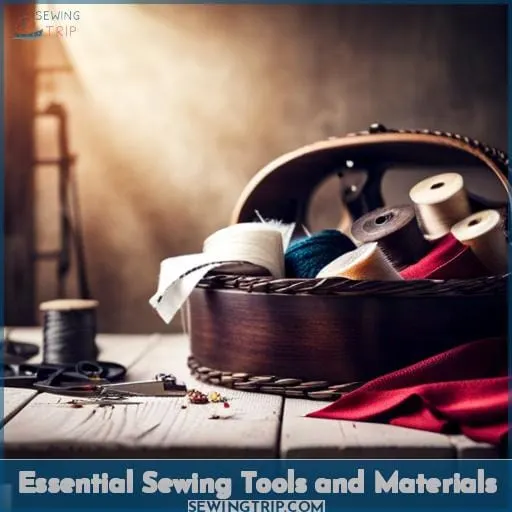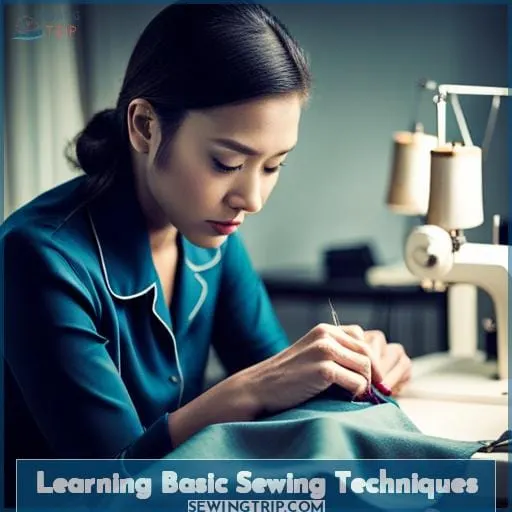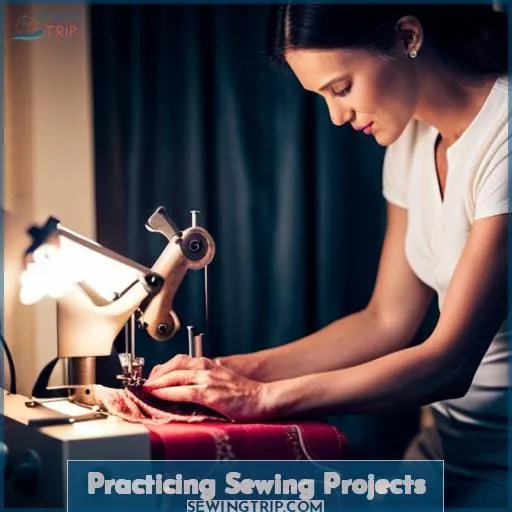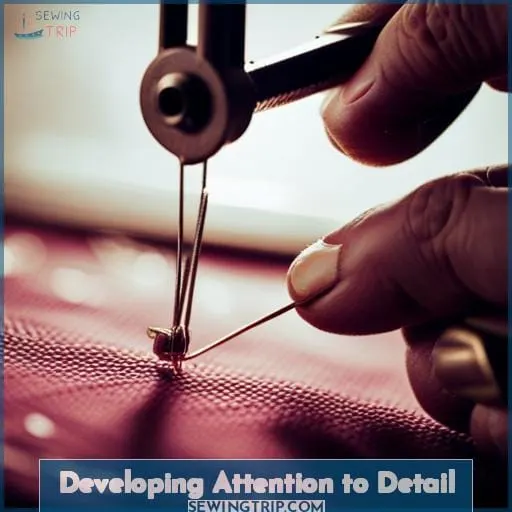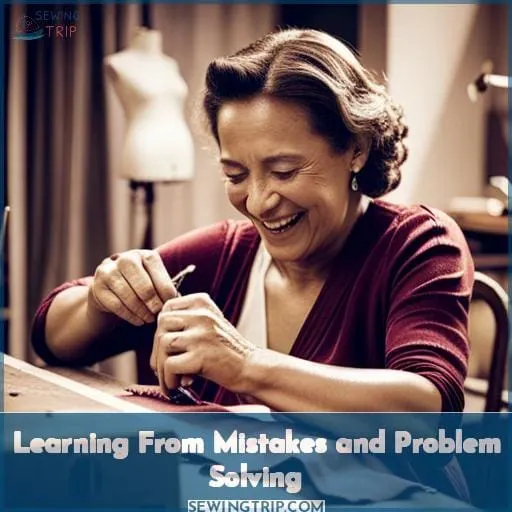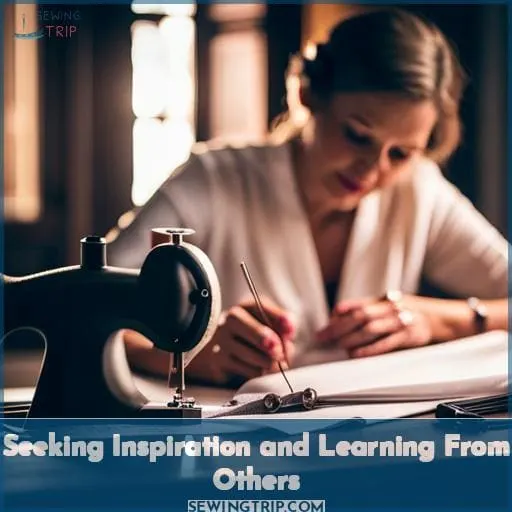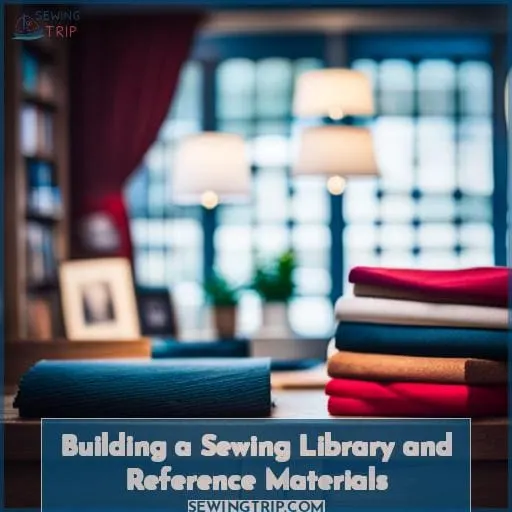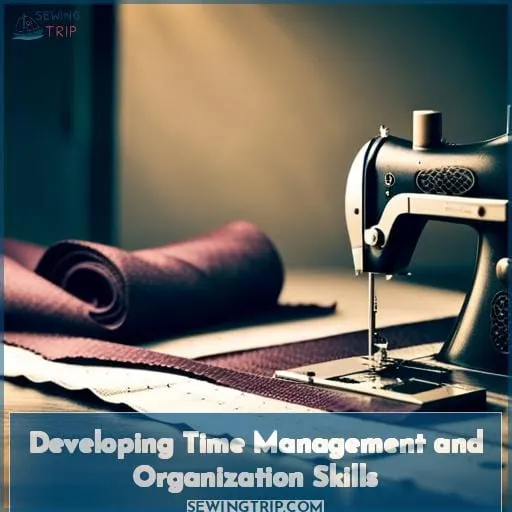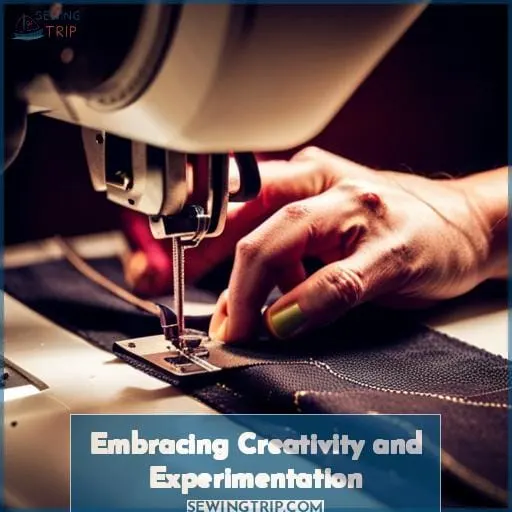This site is supported by our readers. We may earn a commission, at no cost to you, if you purchase through links.
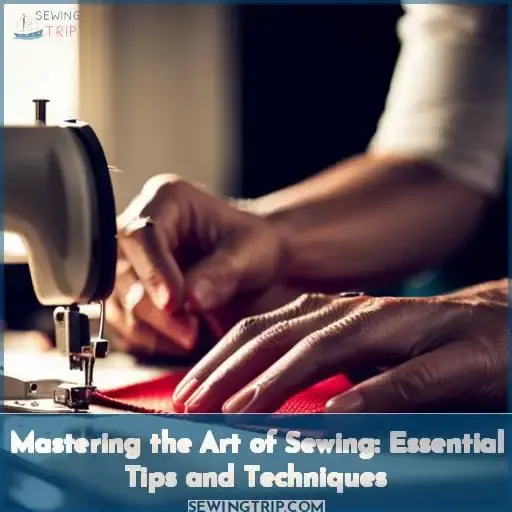 Tired of struggling with your sewing projects? Don’t worry, you’re not alone. Mastering the art of sewing takes time and practice, but with a few essential tips and techniques, you can become a pro in no time.
Tired of struggling with your sewing projects? Don’t worry, you’re not alone. Mastering the art of sewing takes time and practice, but with a few essential tips and techniques, you can become a pro in no time.
In this article, we’ll guide you through everything from choosing the right tools to learning basic sewing techniques.
Table Of Contents
- Key Takeaways
- Why Sewing Skills Are Important
- Essential Sewing Tools and Materials
- Learning Basic Sewing Techniques
- Practicing Sewing Projects
- Developing Attention to Detail
- Learning From Mistakes and Problem Solving
- Seeking Inspiration and Learning From Others
- Building a Sewing Library and Reference Materials
- Developing Time Management and Organization Skills
- Embracing Creativity and Experimentation
- Frequently Asked Questions (FAQs)
- Conclusion
Key Takeaways
- Acquire high-quality sewing equipment
- Learn and practice various sewing techniques
- Start with simple sewing projects and gradually increase difficulty
- Develop good sewing skills through continuous learning and organization
Why Sewing Skills Are Important
Why are sewing skills important for you?
As a sewist, mastering the art of sewing offers endless possibilities for creative expression.
By honing your sewing techniques, you can bring to life your own unique designs and create garments that reflect your personal style.
Sewing also provides functional utility, allowing you to mend and alter clothes with ease, ensuring they fit perfectly and last longer.
Moreover, developing sewing skills promotes self-sufficiency by reducing reliance on mass-produced items and empowering individuals to make their own clothing.
Beyond practicality, engaging in the craft of sewing brings therapeutic benefits as it allows for mindfulness and relaxation while working on a project.
From an economic sustainability perspective,
sewing saves money in the long run since homemade garments are typically more cost-effective than store-bought ones.
In summary,
sewing isn’t just about making clothes; it’s about embracing creativity while achieving mastery over this timeless skill that offers both personal satisfaction
and tangible benefits in our daily lives.
Essential Sewing Tools and Materials
When it comes to mastering the art of sewing, having the right tools and materials is essential.
The key items you need in your sewing arsenal are:
- A reliable sewing machine
- Sharp scissors for precise cutting
- High-quality needles for different fabrics
- Durable thread that matches your project’s requirements
- Accurate measuring tools to ensure proper sizing and proportions
These essential tools will help you achieve professional-looking results in all your sewing endeavors.
Sewing Machine
To get started on your sewing journey, you’ll need a reliable and user-friendly sewing machine.
When choosing a sewing machine, consider factors such as:
- Ease of use
- Ergonomic design
- The variety of stitches it offers
Look for machines with advanced features like:
- Embroidery capabilities
- Automatic needle threaders
Compare different models to find the one that suits your needs best.
Don’t forget to maintain your sewing machine regularly to ensure its longevity and optimal performance.
Scissors
How’re you gonna cut your fabrics precisely without a good pair of scissors tailored for sewing?
Invest in stainless steel shears with micro-serrated blades that glide smoothly to prevent fraying.
Keep separate scissors for paper to maintain sharpness.
When tissues catch between blades, carefully tweeze out debris.
Seek scissors suited for fabric weight—delicate silk shears shouldn’t strain on denim.
Master proper technique so blades align correctly with each cut.
Needles
When sewing, it’s essential to have a variety of needles for different types of fabrics and stitching techniques.
There are several needle types available, such as:
- Universal needles
- Ballpoint needles for knits
- Sharp or microtex needles for delicate fabrics like silk or chiffon.
Needle sizes range from 60/8 (fine) to 110/18 (heavy-duty), depending on the fabric thickness.
Regular needle maintenance includes changing them regularly and using a needle threader for easier threading during hand sewing.
Thread
Needles guide your thread through fabric, so you’ll need quality thread that sews smoothly without tangling or breaking.
Assess thread weight and fiber content when selecting, ensuring suitability for your project’s fabric type.
Polyester and cotton covered polyester threads offer strength and flexibility for both hand and machine sewing.
Seek brands like Gutermann and Coats & Clark for consistent performance across various techniques.
Match thread color closely to fabric for minimal show-through.
Regular thread maintenance including winding bobbins smoothly, cleaning machine tension and feed dogs, and using quality needles, allows thread to glide precisely for innovative designs.
Experiment with decorative threads when ready.
Mastering quality thread selection and care empowers beautiful, dimensional finished pieces.
Measuring Tools
To ensure accurate and precise sewing, one of the essential tools you’ll need is a set of measuring tools.
Precision is of utmost importance in creating well-fitted garments and achieving professional results.
When selecting your measuring tools, consider options such as tape measures, rulers, and seam gauges to cater to different measurement needs.
To improve accuracy while measuring for your sewing projects, remember to keep the tape measure taut but not too tight against the fabric and take multiple measurements for consistency.
Digital options are also available for more advanced techniques or if you prefer using technology in your sewing practice.
Learning Basic Sewing Techniques
Now that you have gathered your essential sewing tools and materials, it’s time to learn the basic sewing techniques that will set a strong foundation for your stitching skills.
Sewing straight lines is a fundamental skill that will be used in many projects, while sewing curves adds versatility and creativity to your work.
Understanding how to sew accurate seam allowances ensures professional-looking finishes, and learning different types of stitches expands your repertoire and allows for decorative elements in your creations.
Let’s explore these essential techniques so you can confidently embark on any sewing project with skillful precision.
Sewing Straight Lines
To sew straight lines, you’ll need to:
- Position your fabric accurately and guide it steadily through the sewing machine.
- Achieve stitch consistency is key for professional-looking results.
Consider these tips:
- Select a sewing machine with appropriate throat size for your projects.
- Wind the bobbin correctly to ensure smooth stitching.
- Adjust tension settings based on fabric compatibility.
Sewing Curves
Sew curves with confidence as you navigate the fabric smoothly and accurately. Mastering curved seams is essential for creating well-fitted garments and achieving professional-looking results.
| Tip | Description |
|---|---|
| 1 | Use pins or clips to hold the fabric in place before sewing, ensuring it doesn’t shift or stretch while stitching. |
| 2 | Consider using a walking foot attachment on your sewing machine when working with difficult fabrics like denim, jersey, faux leather, or cotton canvas. This will help prevent uneven feeding of the layers as you sew around curves. |
Sewing Seam Allowances
When sewing seam allowances, it’s important to maintain a consistent width between the edge of your fabric and your stitching line.
Using the appropriate stitch length on your sewing machine is crucial for different fabric choices – shorter stitches for lightweight fabrics like polyester and longer stitches for heavier fabrics like fleece.
Understanding how to alter patterns to accommodate different seam allowances will allow you more versatility in executing any sewing project with precision and control.
Sewing Different Types of Stitches
You’ll frequently use different types of stitches when sewing, so it’s important to understand their purpose and how to execute them effectively.
Mastering basic stitch variations like the straight stitch and zigzag stitch will give you versatility in your projects.
Experiment with decorative edges using techniques like satin stitching or embroidery basics for added flair.
Additionally, learning seam finishes such as French seams or overlocking will ensure a professional look for your garments.
Don’t forget to keep your sewing tools in good condition for optimal performance!
Practicing Sewing Projects
As you continue to develop your sewing skills, it’s important to practice sewing projects that align with your current skill level.
Start with simple projects designed for beginners, such as making a basic tote bag or pillowcase.
Gradually increase the difficulty of your projects by trying different types of fabrics and experimenting with various techniques like appliqué or pleating.
This won’t only help you refine your skills but also expand your creativity and confidence in tackling more complex sewing endeavors.
Simple Sewing Projects for Beginners
To further develop your sewing skills, it’s important to practice with simple sewing projects on a regular basis.
Start by making a simple garment like a basic skirt or top. This will allow you to learn essential stitching techniques and gain confidence in working with different fabrics.
Experiment with stitch variations and explore fabric selection options to understand their impact on the final product.
Additionally, try incorporating embroidery basics and alteration techniques into your projects for added creativity and skill-building opportunities.
Gradually Increasing Difficulty
As you progress in your sewing journey, it’s important to gradually increase the difficulty of your projects to challenge yourself and improve your skills.
By taking on more advanced techniques and tackling challenging projects, you can continue to grow as a sewist and create masterful creations. This skill progression allows for a sense of accomplishment and fulfillment as you conquer expert level sewing projects.
Whether using the Janome MC-6300P or Singer Fashion Mate 7256, embrace the opportunity to push yourself by gradually increasing difficulty in your sewing projects.
Trying Different Types of Fabrics
When practicing sewing projects, challenge yourself by experimenting with various types of fabrics.
-
Fabric Selection:
- Choose different materials like cotton, silk, linen, and denim to explore their unique characteristics.
-
Material Varieties:
- Try working with stretchy knits or delicate lace for a change in texture and difficulty level.
-
Textile Exploration:
- Dive into the world of prints and patterns by using floral fabrics or bold geometrics.
-
Cloth Diversity:
- Embrace the diversity of textiles by sewing with unconventional materials such as leather or vinyl for exciting new projects that push your skills to new heights
Experimenting With Different Techniques
Try incorporating different sewing techniques into your projects to enhance your skills and expand your creativity.
- Explore stitch variations, such as decorative stitches or unique combinations of basic stitches, to add visual interest to your garments or home decor items.
- Experiment with fabric manipulation techniques like pleating, gathering, or smocking for added texture and dimension.
- Learn embroidery techniques like hand embroidery or machine embroidery to create intricate designs on fabric surfaces.
- Get creative with embellishments by adding appliques, trims, beads, or sequins for a personalized touch.
- Finally,pattern innovations can bring new life and style options into traditional patterns.
Developing Attention to Detail
To become a masterful seamstress, developing attention to detail is crucial.
Precision in cutting fabric ensures accurate measurements and clean edges for your projects.
Accurate pinning and marking guarantee that your pieces align perfectly during construction.
Seam finishing techniques add professional touches to your garments, while proper pressing and ironing create crisp seams and smooth fabrics.
By paying close attention to these details, you can elevate the quality of your sewing workmanship significantly.
Precision in Cutting Fabric
To achieve precision in cutting fabric and develop your attention to detail, start by using sharp scissors or a rotary cutter.
Here are some essential tips for achieving accuracy in your cuts:
- Use a cutting mat to protect your work surface and ensure clean cuts.
- Measure and mark the fabric with a ruler and cutting guide before making any cuts.
- Pay attention to the fabric grain and selvage when positioning it on the cutting mat.
- Securely pin or baste layers of fabric together before cutting for more accurate results.
- Pressing seam allowances flat after cutting will help maintain their shape during sewing.
Accurate Pinning and Marking
- Ensure precise sewing by accurately pinning your fabric and marking stitching lines before beginning any project.
- Consider the fabric type when determining pin placement to avoid damage or distortion.
- Use marking tools that provide clear visibility on different fabrics, such as washable markers or chalk pencils.
- Practice various pinning techniques, adjusting the pressure based on fabric thickness for maximum accuracy.
- Explore different marking methods like tailor’s tacks or tracing paper to ensure durability and easy removal of markings after sewing is complete.
| Pin Placement | Fabric Type | Marking Tools |
|---|---|---|
| Consider | Lightweight fabrics | Washable markers |
| Medium-weight | Chalk pencils | |
| fabric types | Heavyweight +—————————-+ |
+ / Tailor's tacks /
/ Tracing paper /
/ /
Seam Allowances DurabilitySeam Finishing Techniques
After accurate pinning and marking, focus on seam finishing techniques to develop your attention to detail.
Invest in a serger or use a zigzag stitch to prevent fraying raw edges.
Try french seams for concealed inner seams or flat felled seams for durability on outer seams.
Perfect edgestitching, understitching, bindings, facings, and seam allowances.
Compare techniques to determine ideal finishes for each project, considering factors like fabric type, location, and desired effects.
Master various methods to elevate sewing skills.
Pressing and Ironing
Essential Tips and Techniques:
Master the art of sewing by developing attention to detail through proper pressing and ironing techniques.
Invest in quality pressing tools like a steam iron, pressing board, and clapper.
Learn recommended pressing order for sewing projects.
Practice pressing seam allowances, darts, and finished garments.
Pressing transforms sewing projects, so incorporate pressing steps throughout construction.
Proper pressing lends a crisp, professional finish to your sewing.
Learning From Mistakes and Problem Solving
Even experienced sewists encounter mistakes and machine issues. Don’t let setbacks discourage you; see them as opportunities to build your skills.
We’ll cover common errors, troubleshoot machine problems, and tackle fit and construction challenges head on.
Identifying and Fixing Common Sewing Mistakes
After developing your attention to detail, identifying and fixing common sewing mistakes enables valuable learning through problem solving.
When you encounter skipped stitches or puckering fabric, it may indicate uneven tension.
Crooked seams can be fixed by adjusting the alignment of the fabric as you sew.
Thread jams can occur due to incorrect threading or a dull needle.
By carefully identifying these mistakes and implementing appropriate techniques, you can improve your sewing skills and create flawless garments.
Troubleshooting Machine Issues
When troubleshooting machine issues, you’ll find it helpful to identify common sewing mistakes and learn how to fix them.
Be prepared to handle problems like:
- A stuck bobbin
- Issues with the automatic needle threader
- Inability to set stitch length properly
Reference your machine’s manual, watch online tutorials, or bring it in for servicing. With patience and practice, you’ll gain mastery in keeping your sewing machine running smoothly.
Finding Solutions to Fit and Construction Problems
If you frequently encounter fit and construction problems while sewing, it’s time to become a problem-solving pro.
Assess what specifically needs adjusting in the garment or pattern by trying it on, pinning alterations, and making notes.
Experiment with simple solutions like adding darts or adjusting seam allowances before drastically altering a pattern.
Seek advice from sewing references and communities when solutions aren’t apparent.
Stay motivated by focusing on learning.
Seeking Inspiration and Learning From Others
As your skills grow, seek out opportunities to further develop your techniques.
From sewing blogs to local workshops, surrounding yourself with creative people will open your eyes to new methods.
An inspired, collaborative community fuels progress in any craft.
Following Sewing Blogs and Social Media Accounts
You’ll gain sewing inspiration by following popular blogs and accounts on social media.
- Discover new techniques, tips, and tricks from experienced sewists.
- Stay updated with the latest trends in fashion and sewing projects.
- Find solutions to common problems through troubleshooting guides.
- Join vibrant online communities where you can share your own projects and learn from others.
Joining Sewing Communities and Forums
Another great way to seek inspiration and learn from others is by joining sewing communities and forums, where you’re able to connect with fellow sewing enthusiasts.
Online sewing groups provide a platform for sharing ideas, tips, and techniques. You can participate in discussions about various sewing projects or ask questions when facing challenges.
In-person sewing communities offer the opportunity for hands-on learning through workshops or group activities.
Taking Sewing Classes or Workshops
By taking sewing classes or workshops, you’ll fast-track developing your skills from more experienced crafters.
These classes provide a structured and guided learning environment where you can:
- Learn new sewing techniques
- Gain inspiration for your projects
- Receive personalized feedback on your work
The cost of these classes varies depending on the length and level of instruction, but the benefits of hands-on learning and interaction with fellow sewists are invaluable.
However, if attending physical classes isn’t feasible for you, there are online alternatives available that offer convenience and flexibility in learning at your own pace.
Attending Sewing Events and Expos
At sewing expos, you can’t miss opportunities for gaining inspiration and helpful advice.
Wander through aisles of notion vendors and marvel at creative patterns or fabrics that spark new project ideas.
Between shopping, chat with fellow sewists about tricks learned over years at sewing machines to build your skills.
Don’t forget to ask questions of talented exhibitors as you observe them demonstrate new tools live.
Consider attending a workshop, where concentrated learning often proves more valuable than the modest cost of admission.
Building a Sewing Library and Reference Materials
As your passion for sewing grows, you’ll want to build up a sewing library with essential references, resources and inspiration.
Seek out sewing books for beginners to learn techniques, collect sewing patterns and magazines that spark creative ideas, and keep them organized in a sewing notebook or binder for easy access.
Curating your own sewing library fuels learning, creativity and project success.
Essential Sewing Books for Beginners
Your seamstress education starts with essential sewing books bridging gaps in technique for ambitious beginners.
The best sewing books for beginners provide step-by-step instructions, clear illustrations, and valuable tips to help you master the art of sewing.
Whether you prefer physical copies or digital formats like beginner sewing books PDFs, there are plenty of resources available on platforms like Amazon or even free options online.
Building a collection of beginner sewing books will serve as your go-to reference materials and inspire creativity in your future projects.
Collecting Sewing Patterns and Magazines
You’ll build your skills as you collect sewing patterns and magazines to guide your next projects.
- Digital vs. paper patterns
- Vintage vs. modern styles
- Free vs. paid options
- Indie designers vs. major companies
- Adjusting sizes through grading patterns
By curating a diverse reference library, you’ll expand your capabilities to take on exciting new sewing challenges.
Creating a Personal Sewing Notebook or Binder
Frequently, you’re creating a personal sewing notebook or binder to keep all your essential references, tutorials, and project notes organized in one place.
- Use dividers and tabs to categorize different sections such as techniques, patterns, and inspiration.
- Include templates for common shapes like pockets or collars.
- Explore storage options that allow easy access while keeping everything protected.
- Choose binding methods and materials that suit your preferences for durability.
Developing Time Management and Organization Skills
To become a proficient sewist, it’s essential to develop strong time management and organization skills.
Planning your sewing projects and setting deadlines will help you stay on track and complete your work in a timely manner.
Organizing your sewing supplies and materials ensures that everything is easily accessible when needed, saving you valuable time searching for tools or fabrics.
Additionally, creating a dedicated sewing space or studio will provide an organized environment where you can focus on your projects without distractions.
Finally, learning how to manage multiple sewing projects at once allows you to maximize productivity while maintaining orderliness in your workflow.
Planning Sewing Projects and Setting Deadlines
Several more essential tips for mastering sewing involve developing time management and organization skills, like:
- Planning your sewing projects meticulously.
- Setting firm yet achievable deadlines you won’t miss.
Outline each project’s timeline, defining realistic expectations and achievable goals. Use deadlines for motivation while allowing flexibility in your schedule. Careful planning and project management drive sewing success.
Organizing Sewing Supplies and Materials
Keeping your sewing space tidy by organizing your materials into clear storage containers will help you work more efficiently.
Consider using plastic organizers, fabric bins, or clear storage boxes to keep everything in its place.
Label each container for easy identification and retrieval of sewing supplies.
Utilize magnetic sewing tools or a wall organizer to keep frequently used items within reach.
An over-the-door shoe organizer can also be repurposed for storing smaller sewing supplies.
Creating a Sewing Space or Studio
You’ll boost your productivity by designating an area in your home solely for sewing, where you can store supplies efficiently and work without interruption.
Consider the lighting in your sewing space to ensure optimal visibility while working on intricate details.
Adequate storage solutions are crucial for organizing fabrics, notions, and tools.
Ventilation is important to keep the air fresh and reduce any fumes from chemicals or fabrics.
Take into account noise levels when choosing a sewing machine that fits within your budget, such as the Brother LS14S or Janome Horizon 8200 QCP.
Managing Multiple Sewing Projects at Once
When juggling your sewing workload, don’t let disorganization snowball into frustration.
- Prioritizing projects
- Setting deadlines
- Scheduling sewing time
- Creating checklists
Keeping your sewing space tidy and materials organized saves precious time to focus on the fun, creative parts of your projects.
Embracing Creativity and Experimentation
Once you have the basics down, it’s time to make each project uniquely your own.
Personalize your sewing by:
- Playing with embellishments
- Trying new techniques
- Upcycling materials in inventive ways
- Even occasionally stepping outside your comfort zone.
Pushing boundaries and infusing your distinctive style into sewing will keep the craft feeling fresh and satisfying.
Personalizing Sewing Projects With Embellishments
Along with developing your time management skills, you’re ready to start personalizing your sewing projects by embellishing them with ribbons, beads, buttons, and more to embrace creativity and experimentation.
Adorn your creations with trims, appliques, or embroidery for a custom look.
Practice hand-sewing embellishments before using the machine. Start simply with pre-made trim, then advance to beading, surface stitching, or attaching buttons by hand.
Play with different combinations, colors, and placements on practice fabric before embellishing finished projects.
Trying New Sewing Techniques and Styles
By incorporating new techniques like draping and drafting patterns or experimenting with unconventional fabrics, you’re pushing beyond the norm to unlock fresh creative potential.
Consider venturing into hand sewing versus relying solely on the machine. This allows greater control and intricacy for detail-oriented projects.
Additionally, explore novel materials like leather or sequined textiles to ignite inspiration.
Upcycling and Repurposing Materials
Through creative upcycling and repurposing of materials, you’re embracing resourcefulness in your sewing projects.
Rather than discarding old garments or scraps, consider how they could be reused in imaginative ways.
Salvage buttons, zippers, trims, and fabrics for future projects.
Redesign, reconstruct, and renew materials to reduce textile waste.
Donate usable remnants to community craft centers too.
With an inventive spirit, even perceived trash can be upcycled into sewing treasure.
Pushing Boundaries and Stepping Outside Comfort Zones
Now it’s time to push your boundaries and step outside your comfort zone by embracing creativity and experimentation in your sewing projects.
Try using new fabrics that intimidate you or attempt more complex techniques you’ve avoided.
Challenge yourself by taking risks – experiment with difficult patterns, provocative designs, even inventing your own hybrid methods.
Have fun exploring uncharted territory and don’t worry about failure. Growth comes from testing limits, so push through self-doubt and preconceptions by playing with sewing in ways that excite your creative spirit.
Frequently Asked Questions (FAQs)
What are some good entry-level sewing machines for beginners?
Look into the Brother CS6000i for an affordable computerized machine or the Janome Magnolia for a quality mechanical model. Both feature essential tools and capabilities to develop fundamental skills, without overwhelming beginners with complex extras.
Focus initially on learning proper technique – creative possibilities will unfold with experience.
Where can I find sewing patterns for different skill levels?
Check out pattern websites for skill ratings, often indicated with one to four dots, stars, or squares.
Start simple with just one symbol and gradually progress.
Also consult user reviews to discover the actual complexity of various projects before downloading or ordering the patterns.
What fabrics are best for improving sewing skills?
Begin with cottons and linens to build skills.
Their soft drape and forgiving nature help new sewers handle feed and focus on technique.
Move to silks and wools once confident – their slippery and thick textures will test abilities.
Challenge yourself with different fabrics; mastery emerges from experience.
How do I choose the right needles and threads?
Choose the right needles and threads by considering:
- Fabric type
- Weight
- Project requirements
Match needle size to fabric thickness for smooth stitching.
Use compatible thread materials to ensure durability and professional results in your sewing endeavors.
What sewing techniques are important for making clothes versus crafts or quilts?
When sewing clothes, focus on:
- Finishing techniques like clean facings, French seams, and perfect hems.
- Precise cutting and reinforced seams on specialty fabrics.
Quilting demands:
- Accurate quarter-inch seams
- Consistent stitching for beautiful patterns.
Conclusion
Sewing miracles happen when you devote yourself wholeheartedly to the craft!
By embracing creativity, seeking inspiration, and developing essential techniques, you’ll be astounded at the masterpieces you create.
With patience and practice, you too can attain sewing mastery.
Just take that first stitch – a world of sewing possibilities awaits.


